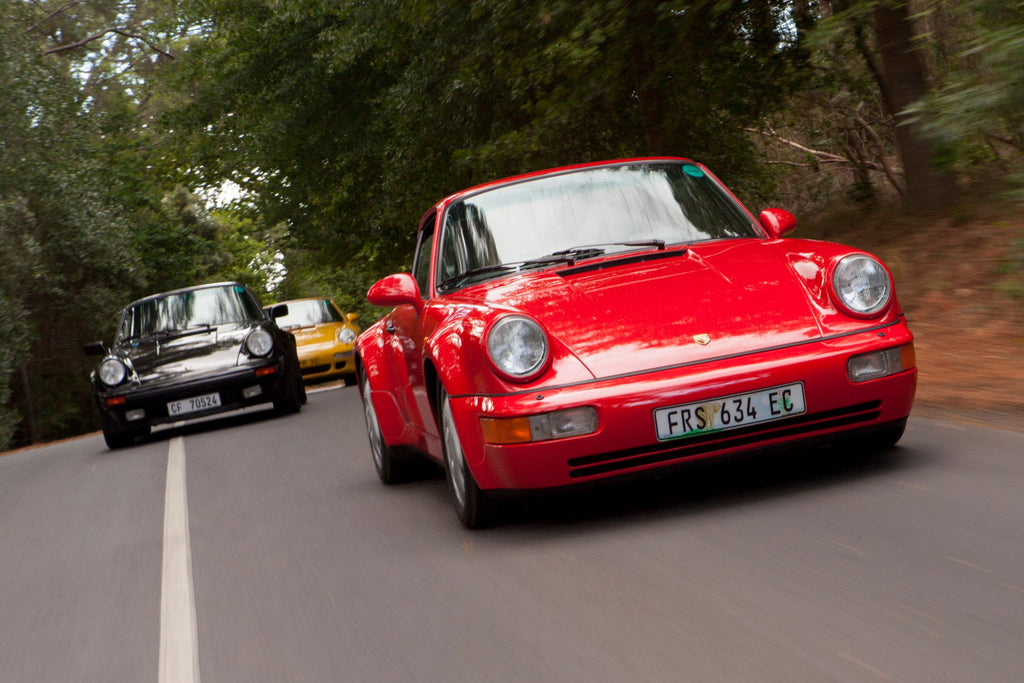Porsche 911 Turbo: the air-cooled era

The 992-generation Porsche 911 Turbo has been making headlines of late, but in this article we get behind the steering wheels of three of its air-cooled predecessors - icons that have laid the foundation on which the 911 Turbo myth is built.
Behold the unmistakable sight of widened arches, bigger Fuchs wheels and that iconic whaletail... These are the unforgettable characteristics of the original 911 Turbo, released 46 years ago in 1974. Aside from these (now traditional) cosmetic upgrades compared to the standard 911, the Turbo set a new benchmark in the '70s in terms of performance, not only in the 911 or Porsche ranges, but in the automotive industry as a whole.
A new beginning

A new dawn for everyday performance arrived with the introduction of the Type 930 911, while the Turbo model quickly gained a fanatical following as Porsche’s quickest production car (at the time). The later forced-induction 911s may have gained in power and gadgetry, but the air-cooled Turbos carry a reputation for being largely unmatched in terms of delivering a memorable driver experience.
Do they live up to that reputation today? Well, we gathered three stunning examples for a test drive in the Winelands region of South Africa, to find out.
- Love the 911 Turbo? Then you'll probably like our Turbo T-shirt, available in limited numbers, here.
At the beginning

When the first deliveries of the 930 Turbo started in the spring of 1975, the automotive industry was enduring a challenging time. It was only a year after the OPEC oil crisis, which added to the misery in the stock markets which were in the midst of a two-year crash cycle. Regardless, the world still took notice when Porsche unveiled the impressive 930 Turbo at the 1974 Paris Motor Show. The first forced induction 911 attracted international attention as one of the fastest cars of the time, and moreover, it was undoubtedly one of Porsche’s most luxurious cars to date. The idea in 1974 was to produce a limited run of only 1 000 Turbo units, but demand surpassed Porsche’s rather conservative expectations, and instead 2 876 of the first 3,0-litre-engined cars were sold.

It is often written that the Turbo technology implemented in the 911 range came as a result of the turbocharged flat-12 cylinder Type 917 engine’s success in the 1972 and 1973 Can-Am championships. However, this doesn’t tell the full story, and, if anything, it only scratches the surface.
Porsche had already fettled with turbocharging on the Type 901 2,0-litre engine in 1969, but found it premature and delayed any further experimenting. After some more development in later years, the 3,0-litre turbocharged engine derived from the Carrera RS was fitted to the 911.
The 930

This black 930 dates from the later 3,3-litre generation, which started production in late 1977. It is remarkable how the 930’s interior has withstood the test of time – although there are a few rattles, it still feels solid for a car of its age. Luxury items at the time included electric windows, an electric sunroof, air-conditioning and a stereo cassette player. You can also appreciate the iconic flat dashboard with lower step, an interior characteristic that has changed little across the 20-year timespan of the three air-cooled Turbo models.
If you consider that this particular car was produced in 1980, it still feels incredibly quick by modern standards. Weighing 135 kg less than the 964 Turbo, 100 km/h is reached in a very respectable 5,4 seconds. Owing to the four-speed gearbox on this specific model, each gear is longer than those in the 964 and 993.

As can be expected, the 930's engine exhibits a significant amount of turbo lag. The wrong timing on exiting a corner – in terms of throttle input – can catch you out, as even the owner here only grudgingly, but with a smile, confirms by referring to his previous night’s drive. You have to anticipate the boost from the single turbocharger, and it’s a part of a game you will need to play in order to master the car and its rather eccentric acceleration.
The rawness of the acceleration, once on boost however, more than makes up for the much-talked-about lag, and the 930 serves up a physical driving experience that modern cars just can’t match. With none of the driver aids fitted to later models, the rawness of the 930 drive means it’s the iconic Turbo model, warts and all.
The 964

Porsche reintroduced the Turbo – under Type 964 guise – in December 1990. Featuring a 930-esque wide-bodied version of the standard 964, Porsche at first opted to tweak the Type 930/68 unit with a larger intercooler rather than develop a new engine, which upped the power slightly to 235 kW.
However, the engine size increased to 3,6 litres in the Turbo II (still 964), with most parts based on the new M64/01 engine being used in the rest of the 911 range. The turbocharged M64/50 engine used new pistons, and boost pressure was increased from 0.82 to 0.92 bar by simply placing a stronger spring in the wastegate. In the process Porsche was able to bump the power up from 235 in the 3,3-litre to 265 kW, and as such the 964 doesn’t suffer from quite as much turbo lag as the 930.

The first noticeable mechanical difference as you pull away is the slick and direct-shifting G50 five-speed gearbox. Gone is the loose and vague shift sensation from the 930. The seats are electrically adjustable too, and with little effort I am able to move into the perfect driving position. With a lower seating position, you immediately feel more in control of the car than in the 930.

Of the three cars present, the 964 actually offers the most support. Maybe it is because of the seats' age and regular use, but the driver sinks far enough into the chairs, while the side bolsters protrude more than in the other two cars. The upright window gives you a good view while, as was the case with the 930, the iconic headlights help the driver direct the car perfectly through corners.

It is the middle child, but it does feel that tad more modern than the pioneering 930. Moreover, the steering wheel feeds the driver a good level of information from the road, while turn in is good, though not as crisp as in the 993. Make no mistake, it makes for a similarly challenging drive as the 930, and the continued rear-wheel drive nature of the car means that if you really want to push one of these, you had better be handy at the wheel.
New performance level – the 993

The 993 Turbo was a game changer; a technological conqueror. Revealed at the 1996 Geneva Motor Show, this model introduced four-wheel drive to the 911 Turbo range for the first time, a drivetrain we experience in the 911 Turbo to this day. Purists might dismiss this characteristic as spoiling the spirit of the Turbo, but it undoubtedly improves the roadholding. Implementing twin low-inertia turbos for the first time, the 993’s M64/60 engine gained 35 kW over the 964, and in the process of sending torque to the front axle the Turbo became a true all-weather supercar.

The yellow car in this collection is a relatively unique model. Powered by the more "vigorous" 336 kW engine, it also features stiffer suspension and the 993 GT2’s exhaust system. It has noticeably wider exhaust tips and a harsh, rough metallic sound as you go through the rev range. This increase in power over the standard 300 kW engine comes from, to name a few, bigger intercoolers and turbos, while the engine management system has also been altered.

The later 997 and even 996 Turbos are renowned for their analogue-like feel, but from behind the 993’s four-spoke steering wheel that feeling is amplified.
Firstly, the six-speed gearbox has a similar action to the 964's. It slots perfectly into each gear, and does so quickly. In first gear the rev needle swings around the dial with serious pace. In second gear I actually make sure that I watch the needle as it touches 7 000 r/min. This upgraded engine makes the sheer performance felt in every gear. With so little turbo-lag, you quickly realise there’s no need to wait for the kick from the engine, as it is available almost immediately – an impressive feat for a 25-year-old car!

As rain begins to fall in the beautiful Winelands region, the four-wheel-drive 993 should be the better and safer choice, or so I thought. After 20 minutes of driving and marveling at how the rear wing is melted over those fat hips in the side-view mirror, I pull away from the traffic lights with haste. I ease through first gear and use the best part of 6 000 r/min through second gear before I hook into third. For a brief moment, all four wheels break traction before I lift off the throttle...
The moral here is that despite the aid of four-wheel drive, the 993 Turbo can still be lethal in the wrong hands. Like its 964 and 930 predecessors, utmost care must be exercised when behind the wheel.

It shows that in an age where most cars have several electronic devices – some of them for safety – and where PDK is increasingly seen as the obvious choice, these air-cooled cars can’t be further removed from today’s highly advanced 911s.
It is sometimes difficult to evaluate each of these cars in isolation. But drive them back-to-back, and you quickly realise that they form one continuous interlocking narrative – one which saw the 911 Turbo’s plot further unfold this year.
Specifications
930 Turbo (1980)

Engine: 3,3-litre, flat-six, turbopetrol
Compression ratio: 7.0:1
Maximum power: 221 kW at 5 500 r/min
Maximum torque: 440 N.m at 4 400 r/min
0-100 km/h: 5,4 seconds
Top speed: 260 km/h
Transmission: Four-speed manual
Suspension front: Independent MacPherson struts, longitudinal torsion bars, anti-roll bar and telescopic dampers
Suspension rear: Independent semi-trailing arms, transverse torsion bars and double-acting telescopic dampers
Weight: 1 335 kg
964 Turbo (1993)

Engine: 3,6-litre, flat-six, turbopetrol
Compression ratio: 10.8:1
Maximum power: 265 kW at 5 500 r/min
Maximum torque: 540 N.m at 4 500 r/min
0-100 km/h: 4,8 seconds
Top speed: 280 km/h
Transmission: Five-speed manual
Suspension front: Independent MacPherson strut with concentric coil springs
Suspension rear: Independent semi-trailing arms with track-correcting bushings
Weight: 1 470 kg
993 Turbo (1996)

Engine: 3,6-litre, flat-six, turbopetrol
Compression ratio: 8.0:1
Maximum power: 300 kW at 5 750 r/min
Maximum torque: 520 N.m at 4 200 r/min
0-100 km/h: 4,5 seconds
Top speed: 290 km/h
Transmission: Six-speed manual
Suspension front: Independent MacPherson strut with aluminum control arms, stabiliser bar
Suspension rear: Independent multi-link LSA axle with toe correcting characteristics, stabiliser bar
Weight: 1 500 kg
